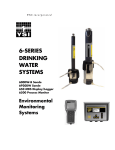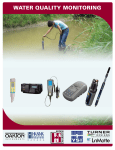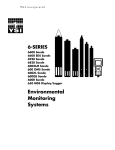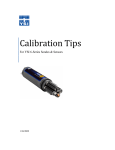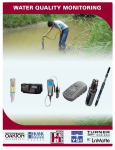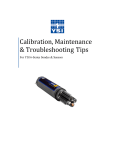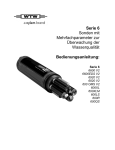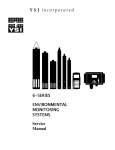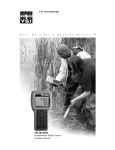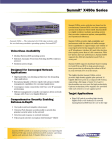Download YSI 6 series User manual
Transcript
6-Series Sonde Quick Start Guide This document will assist an experienced user with the steps required to make your YSI 6-Series product operational. ! When installing probes, be careful not to cross-thread the probe nuts. If you meet resistance while finger-tightening, STOP, back out, and begin again. For full instructions, please refer to the 6-Series User Manual. Unpacking and Inspection Inspect the outside of the shipping container(s) for damage. If you see any damage, contact your shipping carrier immediately. Remove the equipment from the shipping box. Some parts are loose in the box, so check the packing material carefully. Check off all items on the packing list and inspect them for damage. Items Needed • Sonde • Probes • Calibration cup • Probe guard • Batteries (if sonde has battery compartment) • DI water • Flathead screwdriver • Calibration standards • Communication or field cable If using 6562 DO probe: • 6570 maintenance kit • 5775 membrane kit • Razor blade Preparing Sonde for Use To prepare the sonde for operation, you will need to: • Install a new membrane on the YSI 6562 DO Probe, if you are using this item. • Install probes (sensors) into the connectors on the sonde bulkhead. • Provide power for the sonde through batteries or line power. • Connect a field cable or PC communication cable. ! It is important to calibrate all sensors prior to using the sonde for field measurements. Refer to Section 2.6.2 of the 6-Series User Manual. Installing Membrane on 6562 DO Probe (Skip to next section if you are not using this probe) The 6562 Rapid Pulse™ Dissolved Oxygen probe is shipped with a protective dry membrane on the sensor tip. Remove the O-ring and membrane. Handle the probe with care. It is important not to scratch or contaminate the sensor tip. necessary, shake off electrolyte and start over. 4. Secure a membrane between your left thumb and the probe body. Touch membrane only at the ends. Installing Probes ! Before installing any probe into the sonde bulkhead, be sure that the probe port is free of moisture. Use a Kimwipe™ or lintfree cloth to dry. 1. Remove the calibration cup from your sonde, if necessary. be removed. 5. With the thumb and forefinger of your right hand, grasp the free end of the membrane and gently stretch it up, over, and down the other side of the sensor. The membrane should be stretched below the ridge where the O-ring seats so a good seal is achieved. Open the 6562 DO Probe Kit and follow these steps: 6. Secure the end of the membrane under the forefinger of your left hand. 3. Some probes can only be installed into specific ports. Refer to Section 2.3 of the 6Series User Manual for port designations. ! The DO sensor on the 600R/QS cannot 1. Prepare the electrolyte solution as specified 7. Roll the O-ring over the end of the probe, being careful not to touch the membrane on the bottle. surface with your fingers. 2. Put/keep the protective cap on the 8. If bubbles or wrinkles are present, remove connector end of the probe to protect it from the membrane and repeat steps 3-7. contamination. 3. Hold the probe in a vertical position and apply a few drops of KCl solution to tip. The fluid should completely fill the small moat around the electrodes—and create a large meniscus on the probe face. Be sure no air bubbles are stuck to the face of the sensor. If 9. Trim excess membrane with a razor blade. Rinse off any excess KCl solution, but be careful not to get any water in the connector. Refer to Section 2.3 of the 6-Series User Manual for complete instructions and photos. 2. Using the long end of the probe installation tool supplied in the 6570 Maintenance Kit, remove the port plug from the port. 4. Apply a thin coat of lubricant (Krytox™) to the O-rings on the connector side of the probe. ! Make sure there are NO contaminants between the O-ring and the probe. Contaminants will cause leaks when the sonde is deployed. 5. Optical probes (6025 chlorophyll, 6130 Rhodamine, 6131 phycocyanin blue-green algae, 6132 phycoerythrin blue-green algae, 6136 turbidity, and 6150 ROX DO): Insert the probe in the appropriate optical port, seating the pins of the two connectors. Handtighten the probe nut to the bulkhead. Finish tightening the probe using the short end of the installation tool. Do not over-tighten. 6. 6562 Rapid Pulse DO, 6560 conductivity/ temperature, 6561/6579 pH, or 6565/6569 pH/ORP probes: Insert the probe into the appropriate port, seating the pins of the two connectors. Push the probe inward so that it seats into the port. Screw down the probe nut by hand until it is finger tight. Use the long end of the installation tool to tighten the probe a quarter turn or until snug. Do not overtighten. 7. Ammonium, nitrate, and chloride ISE probes do not have slip nuts and should be installed without tools. Seat the probe body directly on the sonde bulkhead. Use your fingers to tighten. 6-Series Sonde Quick Start Guide This document will assist an experienced user with the steps required to make your YSI 6-Series product operational. ! When installing probes, be careful not to cross-thread the probe nuts. If you meet resistance while finger-tightening, STOP, back out, and begin again. For full instructions, please refer to the 6-Series User Manual. Unpacking and Inspection Inspect the outside of the shipping container(s) for damage. If you see any damage, contact your shipping carrier immediately. Remove the equipment from the shipping box. Some parts are loose in the box, so check the packing material carefully. Check off all items on the packing list and inspect them for damage. Items Needed • Sonde • Probes • Calibration cup • Probe guard • Batteries (if sonde has battery compartment) • DI water • Flathead screwdriver • Calibration standards • Communication or field cable If using 6562 DO probe: • 6570 maintenance kit • 5775 membrane kit • Razor blade Preparing Sonde for Use To prepare the sonde for operation, you will need to: • Install a new membrane on the YSI 6562 DO Probe, if you are using this item. • Install probes (sensors) into the connectors on the sonde bulkhead. • Provide power for the sonde through batteries or line power. • Connect a field cable or PC communication cable. ! It is important to calibrate all sensors prior to using the sonde for field measurements. Refer to Section 2.6.2 of the 6-Series User Manual. Installing Membrane on 6562 DO Probe (Skip to next section if you are not using this probe) The 6562 Rapid Pulse™ Dissolved Oxygen probe is shipped with a protective dry membrane on the sensor tip. Remove the O-ring and membrane. Handle the probe with care. It is important not to scratch or contaminate the sensor tip. necessary, shake off electrolyte and start over. 4. Secure a membrane between your left thumb and the probe body. Touch membrane only at the ends. Installing Probes ! Before installing any probe into the sonde bulkhead, be sure that the probe port is free of moisture. Use a Kimwipe™ or lintfree cloth to dry. 1. Remove the calibration cup from your sonde, if necessary. be removed. 5. With the thumb and forefinger of your right hand, grasp the free end of the membrane and gently stretch it up, over, and down the other side of the sensor. The membrane should be stretched below the ridge where the O-ring seats so a good seal is achieved. Open the 6562 DO Probe Kit and follow these steps: 6. Secure the end of the membrane under the forefinger of your left hand. 3. Some probes can only be installed into specific ports. Refer to Section 2.3 of the 6Series User Manual for port designations. ! The DO sensor on the 600R/QS cannot 1. Prepare the electrolyte solution as specified 7. Roll the O-ring over the end of the probe, being careful not to touch the membrane on the bottle. surface with your fingers. 2. Put/keep the protective cap on the 8. If bubbles or wrinkles are present, remove connector end of the probe to protect it from the membrane and repeat steps 3-7. contamination. 3. Hold the probe in a vertical position and apply a few drops of KCl solution to tip. The fluid should completely fill the small moat around the electrodes—and create a large meniscus on the probe face. Be sure no air bubbles are stuck to the face of the sensor. If 9. Trim excess membrane with a razor blade. Rinse off any excess KCl solution, but be careful not to get any water in the connector. Refer to Section 2.3 of the 6-Series User Manual for complete instructions and photos. 2. Using the long end of the probe installation tool supplied in the 6570 Maintenance Kit, remove the port plug from the port. 4. Apply a thin coat of lubricant (Krytox™) to the O-rings on the connector side of the probe. ! Make sure there are NO contaminants between the O-ring and the probe. Contaminants will cause leaks when the sonde is deployed. 5. Optical probes (6025 chlorophyll, 6130 Rhodamine, 6131 phycocyanin blue-green algae, 6132 phycoerythrin blue-green algae, 6136 turbidity, and 6150 ROX DO): Insert the probe in the appropriate optical port, seating the pins of the two connectors. Handtighten the probe nut to the bulkhead. Finish tightening the probe using the short end of the installation tool. Do not over-tighten. 6. 6562 Rapid Pulse DO, 6560 conductivity/ temperature, 6561/6579 pH, or 6565/6569 pH/ORP probes: Insert the probe into the appropriate port, seating the pins of the two connectors. Push the probe inward so that it seats into the port. Screw down the probe nut by hand until it is finger tight. Use the long end of the installation tool to tighten the probe a quarter turn or until snug. Do not overtighten. 7. Ammonium, nitrate, and chloride ISE probes do not have slip nuts and should be installed without tools. Seat the probe body directly on the sonde bulkhead. Use your fingers to tighten. 6-Series Sonde Quick Start Guide This document will assist an experienced user with the steps required to make your YSI 6-Series product operational. ! When installing probes, be careful not to cross-thread the probe nuts. If you meet resistance while finger-tightening, STOP, back out, and begin again. For full instructions, please refer to the 6-Series User Manual. Unpacking and Inspection Inspect the outside of the shipping container(s) for damage. If you see any damage, contact your shipping carrier immediately. Remove the equipment from the shipping box. Some parts are loose in the box, so check the packing material carefully. Check off all items on the packing list and inspect them for damage. Items Needed • Sonde • Probes • Calibration cup • Probe guard • Batteries (if sonde has battery compartment) • DI water • Flathead screwdriver • Calibration standards • Communication or field cable If using 6562 DO probe: • 6570 maintenance kit • 5775 membrane kit • Razor blade Preparing Sonde for Use To prepare the sonde for operation, you will need to: • Install a new membrane on the YSI 6562 DO Probe, if you are using this item. • Install probes (sensors) into the connectors on the sonde bulkhead. • Provide power for the sonde through batteries or line power. • Connect a field cable or PC communication cable. ! It is important to calibrate all sensors prior to using the sonde for field measurements. Refer to Section 2.6.2 of the 6-Series User Manual. Installing Membrane on 6562 DO Probe (Skip to next section if you are not using this probe) The 6562 Rapid Pulse™ Dissolved Oxygen probe is shipped with a protective dry membrane on the sensor tip. Remove the O-ring and membrane. Handle the probe with care. It is important not to scratch or contaminate the sensor tip. necessary, shake off electrolyte and start over. 4. Secure a membrane between your left thumb and the probe body. Touch membrane only at the ends. Installing Probes ! Before installing any probe into the sonde bulkhead, be sure that the probe port is free of moisture. Use a Kimwipe™ or lintfree cloth to dry. 1. Remove the calibration cup from your sonde, if necessary. be removed. 5. With the thumb and forefinger of your right hand, grasp the free end of the membrane and gently stretch it up, over, and down the other side of the sensor. The membrane should be stretched below the ridge where the O-ring seats so a good seal is achieved. Open the 6562 DO Probe Kit and follow these steps: 6. Secure the end of the membrane under the forefinger of your left hand. 3. Some probes can only be installed into specific ports. Refer to Section 2.3 of the 6Series User Manual for port designations. ! The DO sensor on the 600R/QS cannot 1. Prepare the electrolyte solution as specified 7. Roll the O-ring over the end of the probe, being careful not to touch the membrane on the bottle. surface with your fingers. 2. Put/keep the protective cap on the 8. If bubbles or wrinkles are present, remove connector end of the probe to protect it from the membrane and repeat steps 3-7. contamination. 3. Hold the probe in a vertical position and apply a few drops of KCl solution to tip. The fluid should completely fill the small moat around the electrodes—and create a large meniscus on the probe face. Be sure no air bubbles are stuck to the face of the sensor. If 9. Trim excess membrane with a razor blade. Rinse off any excess KCl solution, but be careful not to get any water in the connector. Refer to Section 2.3 of the 6-Series User Manual for complete instructions and photos. 2. Using the long end of the probe installation tool supplied in the 6570 Maintenance Kit, remove the port plug from the port. 4. Apply a thin coat of lubricant (Krytox™) to the O-rings on the connector side of the probe. ! Make sure there are NO contaminants between the O-ring and the probe. Contaminants will cause leaks when the sonde is deployed. 5. Optical probes (6025 chlorophyll, 6130 Rhodamine, 6131 phycocyanin blue-green algae, 6132 phycoerythrin blue-green algae, 6136 turbidity, and 6150 ROX DO): Insert the probe in the appropriate optical port, seating the pins of the two connectors. Handtighten the probe nut to the bulkhead. Finish tightening the probe using the short end of the installation tool. Do not over-tighten. 6. 6562 Rapid Pulse DO, 6560 conductivity/ temperature, 6561/6579 pH, or 6565/6569 pH/ORP probes: Insert the probe into the appropriate port, seating the pins of the two connectors. Push the probe inward so that it seats into the port. Screw down the probe nut by hand until it is finger tight. Use the long end of the installation tool to tighten the probe a quarter turn or until snug. Do not overtighten. 7. Ammonium, nitrate, and chloride ISE probes do not have slip nuts and should be installed without tools. Seat the probe body directly on the sonde bulkhead. Use your fingers to tighten. Installing Probe Guard The probe guard protects probes during deployment and some calibration procedures. Once the probes are installed, screw on the guard by aligning it with the threads on the bulkhead and turn the guard clockwise until secure. Be careful not to bump the 6562 probe membrane when installing the probe guard. Installing Calibration Cup Installing the calibration cup is performed in the same manner as installing the probe guard. The calibration/storage cup is used for calibration procedures as well as sonde storage when not in use. ! It is important to calibrate all sensors prior to using the sonde for field measurements. Refer to Section 2.6.2 of the 6Series User Manual. Power • External power is required for the YSI 600R, 600QS, 600XL, 600XL V2, 6820 V2, and non-battery versions of 600OMS V2 and 600LS sondes. • Internal batteries power the YSI 6920 V2, 6920DW, 6600 V2, 6600EDS V2, 600XLM, 600XLM V2, 600DW, and battery versions of 600OMS V2 and 600LS sondes. These can also run on external power. • If you have a YSI 650 MDS display or other datalogger, attaching your sonde to it will power the sonde when “power sonde” is enabled. • For lab calibration, a YSI 6067 or 6095 calibration cable and YSI 6038 (110 VAC) or 6037 (220 VAC) power supply is required for sondes without internal batteries. (6095 cable must be used with a field cable.) • Connect the 6038 or 6037 power supply to the 6067 or 6095 cable. After attaching the four-pin connector from the power supply to the pigtail, plug the power supply into the appropriate AC outlet. • When using the sonde’s internal batteries, install batteries prior to test and calibration. • When using the 650 as the interface for sondes with internal power, disable the “sonde power” feature. Conversely, when using the 650 for sondes without batteries, enable the “sonde power” feature. • Expected power supply outputs are: 6VDC = 4AA 12VDC = 8AA 12VDC = 8C If you see significantly differing values from these outputs, the batteries may not have a full charge or may be installed incorrectly. (You can find outputs in “Status” in the sonde menu; see next page.) Refer to Section 2.2 of the 6-Series User Manual for complete details. Communication 6. After establishing connection with EcoWatch, you can configure sonde settings including date/time, sensors, logging, setup, and access stored files. 1. Place the EcoWatch compact disk in your computer’s CD drive. An Installshield Wizard will automatically start on most computers. Follow the prompts to complete the installation. Refer to Section 4 of the 6-Series User Manual or the Help section of the software. Communication to the sonde is started with EcoWatch® for Windows®, the 650 display/ logger, or any terminal emulator. 2. Select the EcoWatch icon on your desktop or from the Windows Program Menu and open the application. 3. Select the sonde icon in the toolbar, and then select the proper Comm port to which your sonde is connected. Refer to the diagram above for Communication Settings. Click “OK” to open a terminal window. 4. The terminal window is white. Type “Menu” after the # sign, press Enter, and the sonde Main menu will be displayed. 5. This software is menu-driven. Select functions by typing their corresponding numbers. You do not need to press Enter after choosing a selection. Type the 0 or Esc key to return to the previous menu. Menu Run = set up sonde for discrete or unattended logging applications Calibrate = access sensors for calibration File = view logged files including the calibration record (.glp file) Status = access firmware version, date and time, battery voltage and estimated life, amount of free memory, and logging status Advanced = view calibration constants, choose Auto Sleep configuration, adjust TDS constant and other sonde settings. Refer to Sections 2.5 and 2.9.8 of the 6-Series User Manual before making any changes to the settings in the Advanced Menu. Technical Support YSI Technical Support is available Monday through Friday 8 am to 5 p.m. Eastern Time. Tel: 800-897-4151 option 1 or +1 937-767-7241 option 1 E-mail: [email protected] Web: www.ysi.com System = access sonde communication settings and instrument identification Report = choose parameters to log and units of measurement Sensor = enable sensors and assign probes to ports item # 069307 dwg # A69307 rev 01 October 2008 Installing Probe Guard The probe guard protects probes during deployment and some calibration procedures. Once the probes are installed, screw on the guard by aligning it with the threads on the bulkhead and turn the guard clockwise until secure. Be careful not to bump the 6562 probe membrane when installing the probe guard. Installing Calibration Cup Installing the calibration cup is performed in the same manner as installing the probe guard. The calibration/storage cup is used for calibration procedures as well as sonde storage when not in use. ! It is important to calibrate all sensors prior to using the sonde for field measurements. Refer to Section 2.6.2 of the 6Series User Manual. Power • External power is required for the YSI 600R, 600QS, 600XL, 600XL V2, 6820 V2, and non-battery versions of 600OMS V2 and 600LS sondes. • Internal batteries power the YSI 6920 V2, 6920DW, 6600 V2, 6600EDS V2, 600XLM, 600XLM V2, 600DW, and battery versions of 600OMS V2 and 600LS sondes. These can also run on external power. • If you have a YSI 650 MDS display or other datalogger, attaching your sonde to it will power the sonde when “power sonde” is enabled. • For lab calibration, a YSI 6067 or 6095 calibration cable and YSI 6038 (110 VAC) or 6037 (220 VAC) power supply is required for sondes without internal batteries. (6095 cable must be used with a field cable.) • Connect the 6038 or 6037 power supply to the 6067 or 6095 cable. After attaching the four-pin connector from the power supply to the pigtail, plug the power supply into the appropriate AC outlet. • When using the sonde’s internal batteries, install batteries prior to test and calibration. • When using the 650 as the interface for sondes with internal power, disable the “sonde power” feature. Conversely, when using the 650 for sondes without batteries, enable the “sonde power” feature. • Expected power supply outputs are: 6VDC = 4AA 12VDC = 8AA 12VDC = 8C If you see significantly differing values from these outputs, the batteries may not have a full charge or may be installed incorrectly. (You can find outputs in “Status” in the sonde menu; see next page.) Refer to Section 2.2 of the 6-Series User Manual for complete details. Communication 6. After establishing connection with EcoWatch, you can configure sonde settings including date/time, sensors, logging, setup, and access stored files. 1. Place the EcoWatch compact disk in your computer’s CD drive. An Installshield Wizard will automatically start on most computers. Follow the prompts to complete the installation. Refer to Section 4 of the 6-Series User Manual or the Help section of the software. Communication to the sonde is started with EcoWatch® for Windows®, the 650 display/ logger, or any terminal emulator. 2. Select the EcoWatch icon on your desktop or from the Windows Program Menu and open the application. 3. Select the sonde icon in the toolbar, and then select the proper Comm port to which your sonde is connected. Refer to the diagram above for Communication Settings. Click “OK” to open a terminal window. 4. The terminal window is white. Type “Menu” after the # sign, press Enter, and the sonde Main menu will be displayed. 5. This software is menu-driven. Select functions by typing their corresponding numbers. You do not need to press Enter after choosing a selection. Type the 0 or Esc key to return to the previous menu. Menu Run = set up sonde for discrete or unattended logging applications Calibrate = access sensors for calibration File = view logged files including the calibration record (.glp file) Status = access firmware version, date and time, battery voltage and estimated life, amount of free memory, and logging status Advanced = view calibration constants, choose Auto Sleep configuration, adjust TDS constant and other sonde settings. Refer to Sections 2.5 and 2.9.8 of the 6-Series User Manual before making any changes to the settings in the Advanced Menu. Technical Support YSI Technical Support is available Monday through Friday 8 am to 5 p.m. Eastern Time. Tel: 800-897-4151 option 1 or +1 937-767-7241 option 1 E-mail: [email protected] Web: www.ysi.com System = access sonde communication settings and instrument identification Report = choose parameters to log and units of measurement Sensor = enable sensors and assign probes to ports item # 069307 dwg # A69307 rev 01 October 2008 Installing Probe Guard The probe guard protects probes during deployment and some calibration procedures. Once the probes are installed, screw on the guard by aligning it with the threads on the bulkhead and turn the guard clockwise until secure. Be careful not to bump the 6562 probe membrane when installing the probe guard. Installing Calibration Cup Installing the calibration cup is performed in the same manner as installing the probe guard. The calibration/storage cup is used for calibration procedures as well as sonde storage when not in use. ! It is important to calibrate all sensors prior to using the sonde for field measurements. Refer to Section 2.6.2 of the 6Series User Manual. Power • External power is required for the YSI 600R, 600QS, 600XL, 600XL V2, 6820 V2, and non-battery versions of 600OMS V2 and 600LS sondes. • Internal batteries power the YSI 6920 V2, 6920DW, 6600 V2, 6600EDS V2, 600XLM, 600XLM V2, 600DW, and battery versions of 600OMS V2 and 600LS sondes. These can also run on external power. • If you have a YSI 650 MDS display or other datalogger, attaching your sonde to it will power the sonde when “power sonde” is enabled. • For lab calibration, a YSI 6067 or 6095 calibration cable and YSI 6038 (110 VAC) or 6037 (220 VAC) power supply is required for sondes without internal batteries. (6095 cable must be used with a field cable.) • Connect the 6038 or 6037 power supply to the 6067 or 6095 cable. After attaching the four-pin connector from the power supply to the pigtail, plug the power supply into the appropriate AC outlet. • When using the sonde’s internal batteries, install batteries prior to test and calibration. • When using the 650 as the interface for sondes with internal power, disable the “sonde power” feature. Conversely, when using the 650 for sondes without batteries, enable the “sonde power” feature. • Expected power supply outputs are: 6VDC = 4AA 12VDC = 8AA 12VDC = 8C If you see significantly differing values from these outputs, the batteries may not have a full charge or may be installed incorrectly. (You can find outputs in “Status” in the sonde menu; see next page.) Refer to Section 2.2 of the 6-Series User Manual for complete details. Communication 6. After establishing connection with EcoWatch, you can configure sonde settings including date/time, sensors, logging, setup, and access stored files. 1. Place the EcoWatch compact disk in your computer’s CD drive. An Installshield Wizard will automatically start on most computers. Follow the prompts to complete the installation. Refer to Section 4 of the 6-Series User Manual or the Help section of the software. Communication to the sonde is started with EcoWatch® for Windows®, the 650 display/ logger, or any terminal emulator. 2. Select the EcoWatch icon on your desktop or from the Windows Program Menu and open the application. 3. Select the sonde icon in the toolbar, and then select the proper Comm port to which your sonde is connected. Refer to the diagram above for Communication Settings. Click “OK” to open a terminal window. 4. The terminal window is white. Type “Menu” after the # sign, press Enter, and the sonde Main menu will be displayed. 5. This software is menu-driven. Select functions by typing their corresponding numbers. You do not need to press Enter after choosing a selection. Type the 0 or Esc key to return to the previous menu. Menu Run = set up sonde for discrete or unattended logging applications Calibrate = access sensors for calibration File = view logged files including the calibration record (.glp file) Status = access firmware version, date and time, battery voltage and estimated life, amount of free memory, and logging status Advanced = view calibration constants, choose Auto Sleep configuration, adjust TDS constant and other sonde settings. Refer to Sections 2.5 and 2.9.8 of the 6-Series User Manual before making any changes to the settings in the Advanced Menu. Technical Support YSI Technical Support is available Monday through Friday 8 am to 5 p.m. Eastern Time. Tel: 800-897-4151 option 1 or +1 937-767-7241 option 1 E-mail: [email protected] Web: www.ysi.com System = access sonde communication settings and instrument identification Report = choose parameters to log and units of measurement Sensor = enable sensors and assign probes to ports item # 069307 dwg # A69307 rev 01 October 2008






